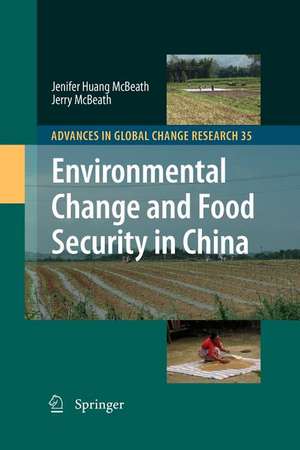Environmental Change and Food Security in China: Advances in Global Change Research, cartea 35
Autor Jenifer Huang McBeath, Jerry McBeathen Limba Engleză Paperback – 28 mai 2012
| Toate formatele și edițiile | Preț | Express |
|---|---|---|
| Paperback (1) | 945.79 lei 6-8 săpt. | |
| SPRINGER NETHERLANDS – 28 mai 2012 | 945.79 lei 6-8 săpt. | |
| Hardback (1) | 951.91 lei 6-8 săpt. | |
| SPRINGER NETHERLANDS – 30 apr 2010 | 951.91 lei 6-8 săpt. |
Din seria Advances in Global Change Research
- 15%
 Preț: 636.12 lei
Preț: 636.12 lei -
 Preț: 439.83 lei
Preț: 439.83 lei - 18%
 Preț: 895.45 lei
Preț: 895.45 lei - 15%
 Preț: 648.24 lei
Preț: 648.24 lei - 18%
 Preț: 1036.54 lei
Preț: 1036.54 lei - 18%
 Preț: 894.16 lei
Preț: 894.16 lei - 18%
 Preț: 963.60 lei
Preț: 963.60 lei - 18%
 Preț: 1239.49 lei
Preț: 1239.49 lei - 15%
 Preț: 649.71 lei
Preț: 649.71 lei - 18%
 Preț: 1243.78 lei
Preț: 1243.78 lei - 18%
 Preț: 1114.02 lei
Preț: 1114.02 lei - 15%
 Preț: 648.89 lei
Preț: 648.89 lei - 18%
 Preț: 960.78 lei
Preț: 960.78 lei - 15%
 Preț: 643.99 lei
Preț: 643.99 lei - 18%
 Preț: 1834.44 lei
Preț: 1834.44 lei - 15%
 Preț: 649.06 lei
Preț: 649.06 lei - 18%
 Preț: 955.70 lei
Preț: 955.70 lei - 18%
 Preț: 956.03 lei
Preț: 956.03 lei - 18%
 Preț: 1232.26 lei
Preț: 1232.26 lei - 18%
 Preț: 955.88 lei
Preț: 955.88 lei - 18%
 Preț: 959.19 lei
Preț: 959.19 lei - 18%
 Preț: 944.82 lei
Preț: 944.82 lei - 18%
 Preț: 1105.19 lei
Preț: 1105.19 lei - 15%
 Preț: 644.49 lei
Preț: 644.49 lei - 15%
 Preț: 643.99 lei
Preț: 643.99 lei - 18%
 Preț: 1841.54 lei
Preț: 1841.54 lei - 18%
 Preț: 1225.94 lei
Preț: 1225.94 lei - 18%
 Preț: 954.62 lei
Preț: 954.62 lei - 5%
 Preț: 1414.80 lei
Preț: 1414.80 lei
Preț: 945.79 lei
Preț vechi: 1153.39 lei
-18% Nou
Puncte Express: 1419
Preț estimativ în valută:
180.97€ • 189.46$ • 149.75£
180.97€ • 189.46$ • 149.75£
Carte tipărită la comandă
Livrare economică 05-19 aprilie
Preluare comenzi: 021 569.72.76
Specificații
ISBN-13: 9789400732032
ISBN-10: 9400732031
Pagini: 324
Ilustrații: X, 340 p. 20 illus.
Dimensiuni: 155 x 235 x 17 mm
Greutate: 0.45 kg
Ediția:2010
Editura: SPRINGER NETHERLANDS
Colecția Springer
Seria Advances in Global Change Research
Locul publicării:Dordrecht, Netherlands
ISBN-10: 9400732031
Pagini: 324
Ilustrații: X, 340 p. 20 illus.
Dimensiuni: 155 x 235 x 17 mm
Greutate: 0.45 kg
Ediția:2010
Editura: SPRINGER NETHERLANDS
Colecția Springer
Seria Advances in Global Change Research
Locul publicării:Dordrecht, Netherlands
Public țintă
ResearchCuprins
Communist Rule and the Food Security Situation.- Immediate Environmental Stressors on Food Security.- Near-Term Environmental Stressors: Climate Change.- Plant Diseases, Pests and Food Security.- Invasive Species and Food Security.- Biotechnological Responses to Food Security Needs.- The Legal and Institutional Framework to Address Food Security Needs.- Issues in Implementing Food Security in China.- Summary and Conclusions.
Textul de pe ultima copertă
With 22 percent of the world’s population but only 7 percent of its arable land, China’s food situation is a matter of global concern. Environmental Change and Food Security in China, is the first to introduce comprehensively the threats to China’s system of food production, distribution, and consumption. It analyzes broad challenges of population growth, urbanization, and extraordinarily rapid economic development. Then it focuses on degradation of China’s land, water and air, water sufficiency, and evidence of climate change effects as they adversely affect the food system. The study investigates plant diseases and pests which take a large toll on agricultural production and also considers alien invasive species.
Normal bureaucratic routines of agricultural, land, water, climatological, and environmental agencies are inadequate to counter these challenges, and the regime has launched large projects (e.g., the South-North Water Diversion Project) and conducted national campaigns (e.g., re- and afforestation programs) which are unprecedented in their scope. Also, China has invested more heavily in agricultural biotechnology research than any other developing country. These responses have insured self-sufficiency in food staples to the present.
The volume evaluates several future problems and issues in China’s approach to food security. Despite attempts to tighten coordination of policy and improve enforcement, as seen in efforts to resolve the tainted products crisis of 2007, the increased autonomy of local governments often frustrates green and clean ambitions of the state. Although the regime has tolerated environmental and other NGOs, allowed the media greater latitude to report bad news, and permitted protests that do not challenge the communist party’s authority, still civil society is weak. While economic development has lifted more than 200 million from poverty, rural/urban inequality increases, pushing the poor intoChina’s cities, and access to food remains a problem for many.
Normal bureaucratic routines of agricultural, land, water, climatological, and environmental agencies are inadequate to counter these challenges, and the regime has launched large projects (e.g., the South-North Water Diversion Project) and conducted national campaigns (e.g., re- and afforestation programs) which are unprecedented in their scope. Also, China has invested more heavily in agricultural biotechnology research than any other developing country. These responses have insured self-sufficiency in food staples to the present.
The volume evaluates several future problems and issues in China’s approach to food security. Despite attempts to tighten coordination of policy and improve enforcement, as seen in efforts to resolve the tainted products crisis of 2007, the increased autonomy of local governments often frustrates green and clean ambitions of the state. Although the regime has tolerated environmental and other NGOs, allowed the media greater latitude to report bad news, and permitted protests that do not challenge the communist party’s authority, still civil society is weak. While economic development has lifted more than 200 million from poverty, rural/urban inequality increases, pushing the poor intoChina’s cities, and access to food remains a problem for many.
Caracteristici
Explores indirect and direct relationships between environmental degradation and food security Comprehensive treatment of major factors influencing China’s food production, consumption and control systems Analyses of actors (national and sub-national officials, scientists, non-governmental organizations, media) involved in food policy formation and implementation Examination of recent controversies—GMOs and human health, "tainted" food product Includes supplementary material: sn.pub/extras














